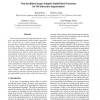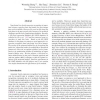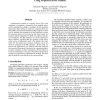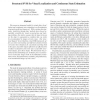ICCV
2009
IEEE
13 years 9 months ago
2009
IEEE
Hybrid generative-discriminative techniques and, in particular, generative score-space classification methods have proven to be valuable approaches in tackling difficult object or...
ICCV
2009
IEEE
13 years 9 months ago
2009
IEEE
Finding the largest consensus set is one of the key ideas used by the original RANSAC for removing outliers in robust-estimation. However, because of its random and non-determinis...
ICCV
2009
IEEE
13 years 9 months ago
2009
IEEE
In the context of variational image segmentation, we propose a new finite-dimensional implicit surface representation. The key idea is to span a subset of implicit functions with ...
ICCV
2009
IEEE
13 years 9 months ago
2009
IEEE
Non-frontal view facial expression recognition is important in many scenarios where the frontal view face images may not be available. However, few work on this issue has been don...
ICCV
2009
IEEE
13 years 9 months ago
2009
IEEE
One important problem in computer vision is to provide a demographic description a person from an image. In practice, many of the state-of-the-art methods use only an analysis of ...
ICCV
2009
IEEE
13 years 9 months ago
2009
IEEE
The varying object appearance and unlabeled data from new frames are always the challenging problem in object tracking. Recently machine learning methods are widely applied to tra...
ICCV
2009
IEEE
13 years 9 months ago
2009
IEEE
We propose a multi-object multi-camera framework for tracking large numbers of tightly-spaced objects that rapidly move in three dimensions. We formulate the problem of finding co...
ICCV
2009
IEEE
13 years 9 months ago
2009
IEEE
A fundamental problem in computer vision (CV) is the estimation of geometric parameters from multiple observations obtained from images; examples of such problems range from ellip...
ICCV
2009
IEEE
13 years 9 months ago
2009
IEEE
We present an integrated model for visual object localization and continuous state estimation in a discriminative structured prediction framework. While existing discriminative `p...
ICCV
2009
IEEE
13 years 9 months ago
2009
IEEE
Measuring image similarity is a central topic in computer vision. In this paper, we learn similarity from Flickr groups and use it to organize photos. Two images are similar if th...





